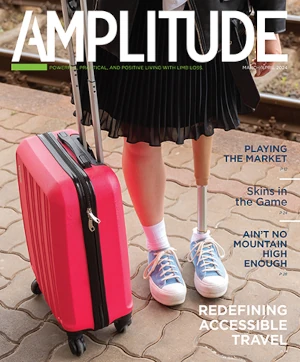Djurica Resanovic had a motorbike accident several years ago that resulted in the amputation of his leg above the knee. Through novel neuroprosthetic leg technology, Resanovic was successfully merged with his bionic leg during clinical trials in Belgrade, Serbia.
“After all of these years, I could feel my leg and my foot again, as if it were my own leg,” reported Resanovic about the bionic leg prototype. “It was very interesting. You don’t need to concentrate to walk, you can just look forward and step. You don’t need to look at where your leg is to avoid falling.”
Scientists from a European consortium led by Swiss institutions, ETH Zurich and Ecole Polytechnique Fédérale de Lausanne (EPFL) spin-off SensArs Neuroprosthetics, in collaboration with institutions in Belgrade, successfully implemented bionic leg technology in clinical trials with three amputees. The results appear in Science Translational Medicine.
“We showed that less mental effort is needed to control the bionic leg because the amputee feels as though their prosthetic limb belongs to their own body,” explained study leader Stanisa Raspopovic, PhD, ETH Zurich professor and co-founder of SensArs Neuroprosthetics.
“This is the first prosthesis in the world for above-knee leg amputees equipped with sensory feedback. We show that the feedback is crucial for relieving the mental burden of wearing a prosthetic limb, which, in turn, leads to improved performance and ease of use.”
Wearing a blindfold and earplugs, Resanovic could feel his bionic leg prototype thanks to sensory information that was delivered wirelessly via electrodes surgically placed into his residual limb’s intact nervous system. These electrodes pierce through the intact tibial nerve instead of wrapping around it.
“I could tell when they touched the [big toe], the heel, or anywhere else on the foot,” said Resanovic. “I could even tell how much the knee was flexed.”
Resanovic is one of three leg amputees, all with above-knee amputations, who participated in a three-month clinical study to test new bionic leg technology.
The fundamental neuroengineering principle is about merging body and machine. It involves imitating the electrical signals that the nervous system would have normally received from the person’s biological leg. Specifically, the bionic leg prototype is equipped with seven sensors along the sole of the foot and one encoder at the knee that detects how much the knee is flexed. These sensors generate information about touch and movement from the prosthesis. Next, the raw signals are engineered via a smart algorithm into biosignals that are delivered into the residual limb’s nervous system into the tibial nerve via intraneural electrodes, and these signals reach the brain for interpretation.
Via detailed sensations from the sole of the artificial foot and artificial knee, all three patients could maneuver through obstacles without looking at their artificial limb as they walked. They could stumble over objects yet mitigate falling. Most importantly, brain imaging and psychophysical tests confirmed that the brain is less involved with the bionic leg, leaving more mental capacity available to successfully complete various tasks.
These results complement a study that demonstrated other clinical benefits of the bionic technology, such as reducing phantom limb pain and fatigue.
This article was adapted from information provided by EPFL.



